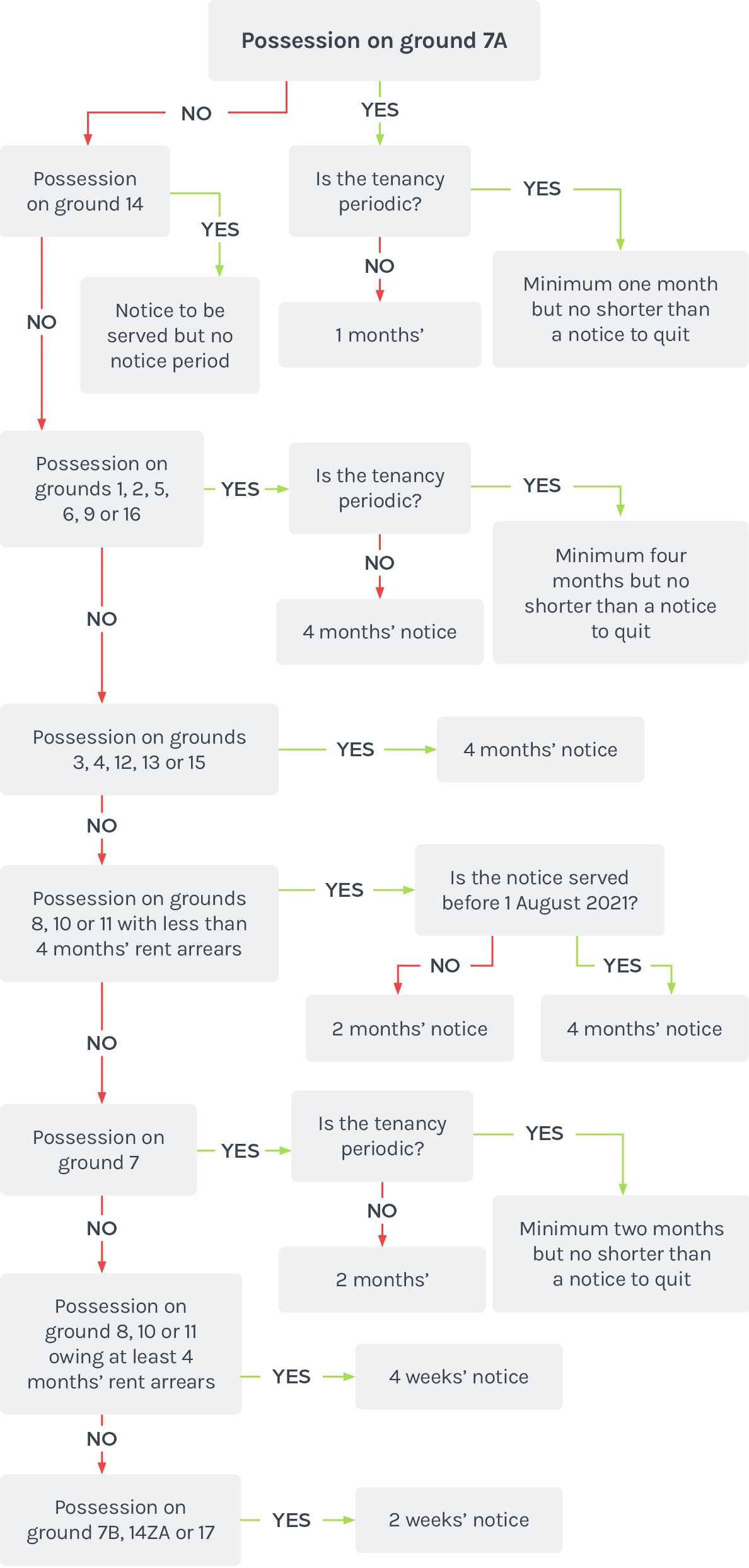Changes to section 8 notice periods in 2021 explained [flowchart]
1 June 2021 saw the latest changes under the Coronavirus Act to the section 8 and section 21 notice procedures in England. Before the COVID-19 pandemic, the grounds of section 8 had differing notice periods of between "no notice period" and two months' minimum. When the pandemic struck, all notice periods for both section 8 and section 21 were moved to three months.
Most grounds were then moved to 6 months in August 2020 in England and July 2020 for Wales. These longer notices were due to expire at the end of March but were extended during March to the end of May in England and the end of June in Wales as the country was still too locked down to consider increasing evictions.
Though they didn't restore them to their pre-COVID notice periods, the changes brought in during the summer of 2020 reintroduced some variety in the length of section 8 notices. Grounds 7A and 14 were taken out of the Coronavirus Act, so any action on those grounds is now simply under the Housing Act 1988. Other grounds were given different lengths of notice to reflect the priorities. For example, it was made easier to get possession on domestic violence and antisocial behaviour grounds. In England, it was made easier to get possession on serious rent arrears (more than six months of rent owed), but this was not duplicated in Wales.
New rules for England from 1 June
On 12 May, new legislation was passed that provided revised notice rules. These have been in force since 1 June 2020 in England. As mentioned above, in Wales, the original rules lasted till the end of June anyway, and so far, the revised rules for Wales have not been announced, but we would expect them to be broadly similar. The following rules are therefore only 'fact' for England.
Section 21
The essence of the latest changes is that six-month notices have generally become four-month notices. For example, section 21 drops its notice period from a minimum of six months to a minimum of four months. To match this, the longer ten-month life span of the notice has been reduced to eight months, essentially still giving four months after the expiry of the notice to start court proceedings.
Section 8
The situation with section 8 is slightly more complex as not only does each ground have a length of time, but multiple grounds on a notice will affect the notice period required in different ways. Some have special rules; for example, ground 7A (the mandatory antisocial behaviour ground) is a 'super ground' and the one month required for this ground trumps any other notice period for any other ground. Ground 14 is similar (though it is still trumped by 7A), and if it is used with or without other grounds (apart from 7A), then no notice period is needed. Some grounds need you to consider if the tenancy is periodic or fixed term, and some don't.
Apart from the special grounds, the general rule is that if you include more than one ground on the notice, the notice must be for the longest notice period required.
All this makes for a fiendishly complex set of possibilities with 20 possible grounds for possession, each with its own rules about how long the notice period should be, as well as potentially different rules for periodic and fixed-term notices.
Section 8 flowchart
To help simplify this, Training for Professionals has produced a flowchart. To use this flowchart, start by deciding which grounds you want to include on the notice. Having done that, read the first box at the top of the flowchart and answer it 'yes' or 'no'. If you chose 'no', follow the arrows until you reach the ground on which you are seeking possession.
The first box that matches your chosen ground or one of your chosen grounds will tell you how long the notice should be. Note that it is only the first ground that matters, not any of the others.
If you want to test the effect of removing a ground from the notice, you can simply try without that ground. For example, if you are seeking possession on ground 1 and ground 17, you will find that the first ground you find is ground 1, requiring at least 4 months' notice. Ground 17 only requires 2 weeks' notice. Removing ground 1 would therefore reduce the notice from 4 months to 2 weeks.
The rules include a change to rent arrears grounds on 1 August. These changes to notice rules are expected to last until the end of September 2021, when it is planned for notices in England to return to their normal, pre-pandemic timings. Of course, this is dependent on the progression of the pandemic.
If you would like a free 30-minute pre-recorded webinar explaining these changes in more detail, please phone Mark on 01258 440425 or email mark@tfponline.co.uk.

For more on section 8 and other legislation, read Fixflo's guide to the Regulatory Changes Affecting Letting Agents and Landlords in 2021.
BLOG DISCLAIMER
This article is intended for information purposes only and does not constitute legal advice. If you have any questions related to issues in this article, we strongly advise contacting a legal professional.
These blog posts are the work of Fixflo and are licensed under a Creative Commons Attribution-ShareAlike 3.0 Unported License. In summary, you are welcome to re-publish any of these blog posts but are asked to attribute Fixflo with an appropriate link to www.fixflo.com. Access to this blog is allowed only subject to the acceptance of these terms.


